Table of Contents
Key Takeaways
- The RFP should present the client’s goals and challenges in detail, as well as provide guidelines on how the consultant will be compensated and any other specific requirements.
- An efficient RFP for consulting should be well-structured, clear, and concise to effectively communicate your requirements to potential consulting firms.
- The end of the game, when writing an RFP for consulting, is to maximize the chances of success of your purchase.
- Thinking outside the traditional RFP for consulting box starts with reminding yourself that you’re not making a purchase. You’re solving a company problem.
- The key elements for an RFP for consulting services is the context, the requirements, and the process.
- Even before you start brainstorming on your ideal outcome, you need to make sure that the right people are in the room and that includes the project sponsor, the project manager, the procurement leader, and the main stakeholders.
- Other elements to include in your RFP are: describe how the selection process will unfold, share the criteria for the decision, give a clear timeline, mention other necessary requirements, and don’t forget to give a single point of contact.
An RFP for consulting services is a document that contains all the information about the project, client’s expectations, and requirements. It is an important part of the selection process because it provides a clear scope of work to consultants and helps them decide if they want to take on this particular project.
The RFP should present the client’s goals and challenges in detail, as well as provide guidelines on how the consultant will be compensated and any other specific requirements.
RFP for Consulting Services: The Definitive Guide (2023) offers readers 8 steps for developing their own RFP for consulting services so that they can improve the ROI of their consulting projects consistently!
Should I Always Write an RFP for Consulting?
The answer is straightforward. Yes, you do.
A request for proposal, or RFP for consulting, is a document you send to consultants to hire them. The idea behind an RFP is to have as many businesses compete against one another so that they can provide their best rates and offer up all their services.
Before crafting this proposal, you’ll need some knowledge about what type of work you want to do. But for consulting firms, the interest in writing an RFP goes beyond the competition itself.
Consulting is an intangible service, and it isn’t easy to describe. Writing well-defined requirements is essential to every successful consulting project, even when there isn’t a call for bids.
Why is RFP for Consulting so Important?
If you want to organize a fair competition, an RFP is the best way to ensure that all bidders are on the same page. The RFP for consulting helps consultants prepare their proposals based on requirements presented by potential clients, so it saves them time too!
In addition to this, an RFP provides well-founded information about a project’s duration and complexity which makes bidding easier. Additionally, clear expectations make it easier to compare the offers more objectively.
It’s also a fantastic way to gather data about the firm. It’s less essential when you work with a company you are familiar with since you already know what they’ll do. However, working with a new consulting firm is an excellent way to get to know their methodologies, references, and resources.
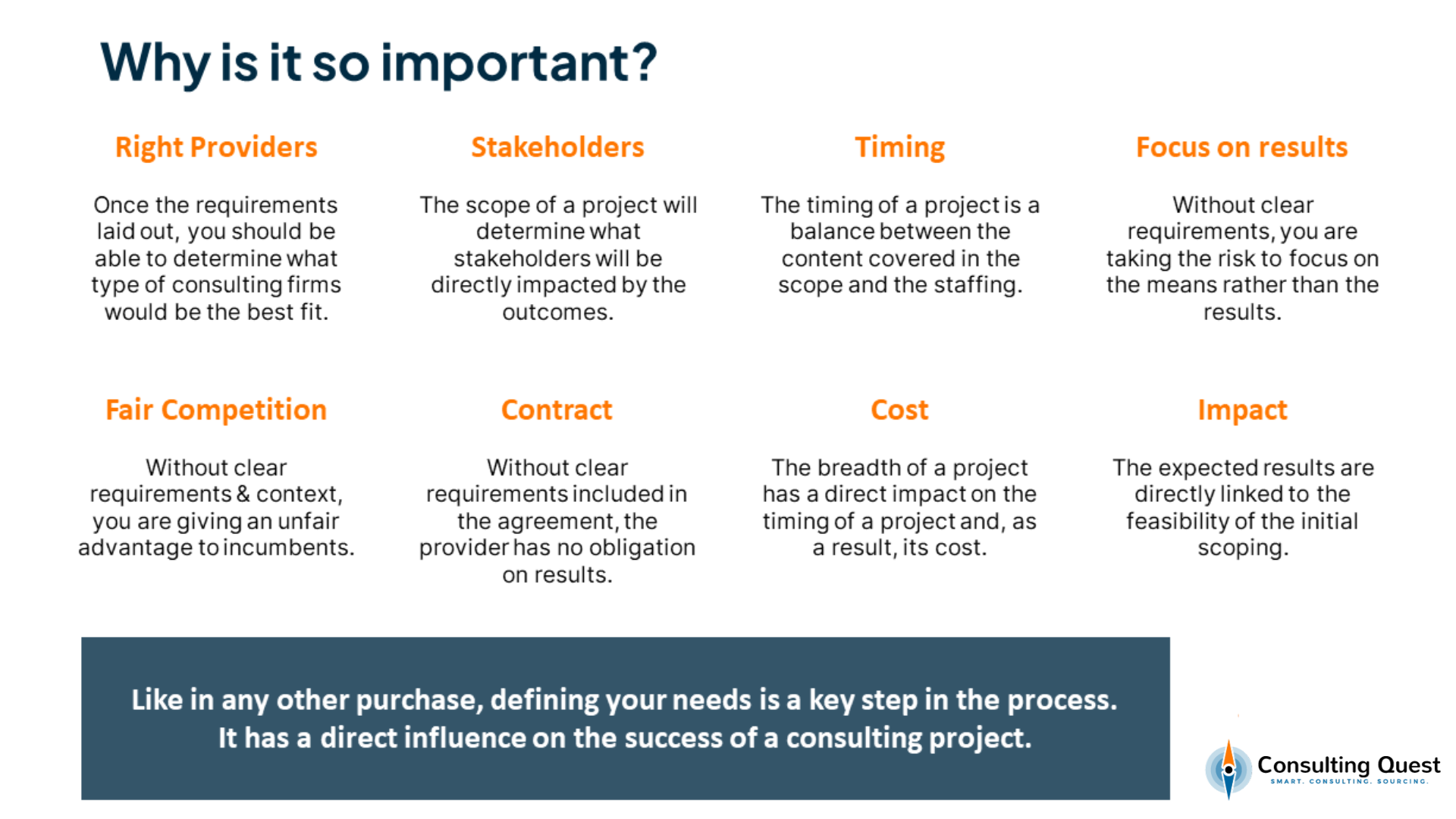
So that’s an excellent approach to getting to know them. And it might not result in a project. However, you will have met them, and maybe you will end up working with them on another project.
It also helps you define the standard for performance evaluation. When you want to measure the performance of a given consulting firm during a project, it’s good to have set the expectation at the beginning so that you have something to compare to.
And last but not least, not all projects are rosy. Sometimes there’s a conflict with the consulting firm, and you must prepare for the worst every time. Having some expectations clarified will help you to discuss with the consulting firms with some solid concrete basis.
But the Interest of an RFP is Not Only About the Selection Process Itself
Defining your needs precisely can also help ensure you only buy what you need. Not more, not less. When executives have so much pressure on OPEX (operating expenses), keeping an eye on your consulting spending and the impact of your projects is vital.
Furthermore, getting people to accept and buy into a project is one of the most challenging aspects of project management. And having them involved in the planning process from the outset will assist you in gaining that buy-in.
Another benefit is that it will give you an answer to a problem you didn’t expect. What’s more, if many individuals are in the room and you ask them to focus on the issue you wish to address rather than the solutions, the results may surprise you.
Is it Always, Always an RFP for Consulting?
Actually, it’s not. And that will depend on where you are in the process of launching a project. Let’s say that you’re on the ideation phase and you’re asking yourself those questions. Should I launch a project, or what are my options to solve that problem?
That means that the needs and the scope are not defined in that case, and your best option is to launch an RFI. It’s a request for information, and you will explore the potential with the consulting firms. And then you will decide if you want to go to the next step. And the next step is the execution phase.
And, at that point, your question would be “What consultants can help me attain my objectives?” When your needs and the scope are clear, you’re ready to launch an RFP for consulting, but actually, there are options in between.
Sometimes you’re clear on the problem to tackle, but not on the approach. In that case, you might want to use a hybrid process, which is mixing the RFI in the first round, for instance, and then an RFP for consulting process.
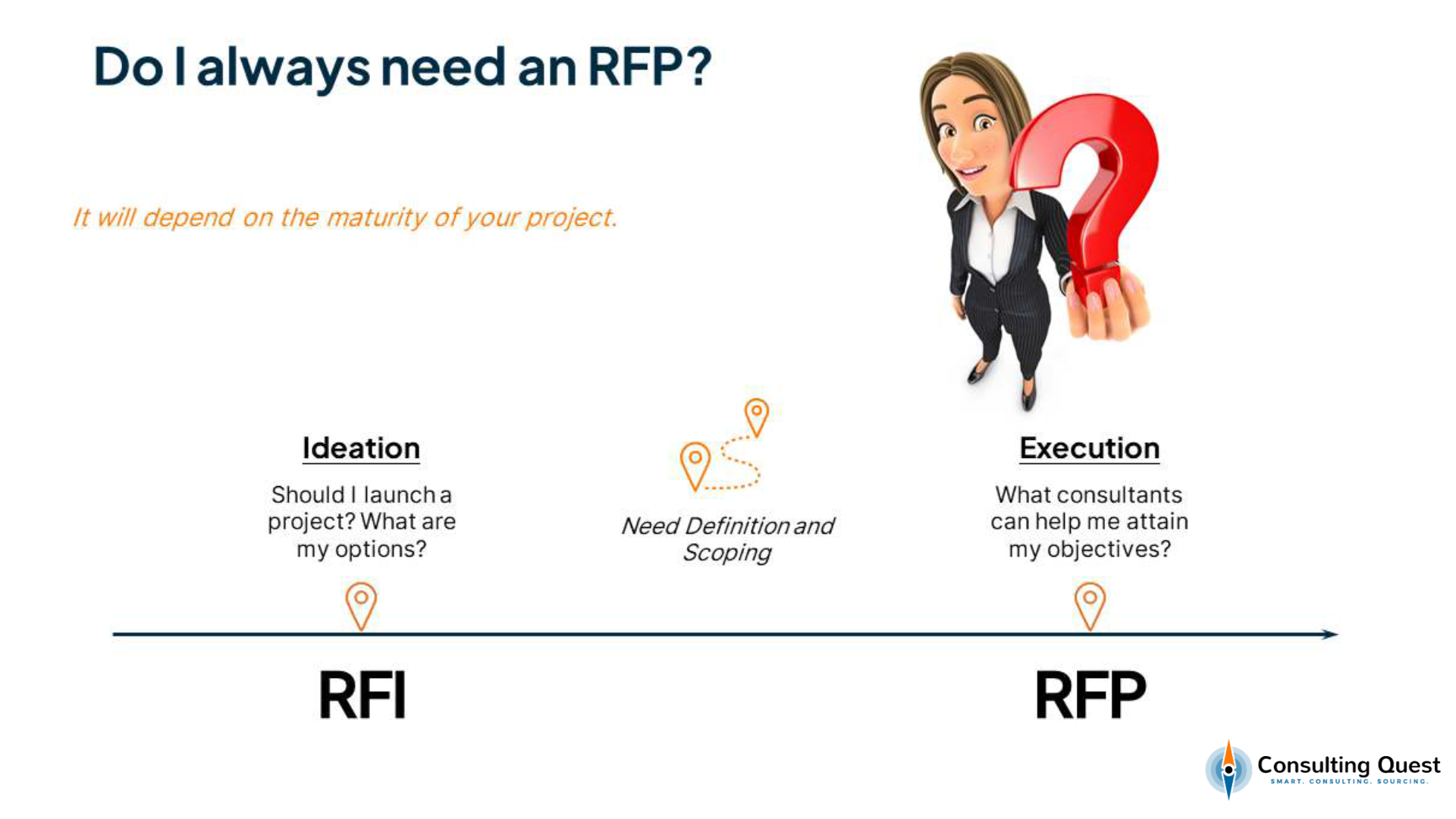
If you are clear on the problem to tackle and the approach to use, but you’re flexible on the delivery model and the format, then you should go for an open RFP where the consultants can get creative, and they can bring you solutions.
RFP for Consulting RFP for Consulting RFP for Consulting RFP for Consulting RFP for Consulting RFP for Consulting RFP for Consulting RFP for Consulting RFP for Consulting RFP for Consulting RFP for Consulting RFP for Consulting RFP for Consulting RFP for Consulting RFP for Consulting RFP for Consulting RFP for Consulting RFP for Consulting RFP for Consulting RFP for Consulting RFP for Consulting RFP for Consulting RFP for Consul
Let’s give you an example: On a project that we worked on a couple of years ago, the clients wanted to roll out a new organization, that had been defined at the other group level, in one of the subsidiaries. And they wanted a consulting firm to help them get the buy-in of the teams, define the interfaces and the new ways of working in that group.
So, we selected several consulting firms and one of them proposed to design a game where the players and all the stakeholders would roleplay their future roles and define those new interfaces.
It was not something that was asked for by the client when we made the RFP for consulting, but that’s the company they worked with and it was very successful.
So, it means, when you leave some room for creativity, you could end up with something that you didn’t think of, but actually is very effective for all your projects.
What Does it Really Mean for the Sourcing Process?
It means that you need more collaboration. You need to get on board the project sponsor, the project leader, the procurement leader, and the main stakeholders to really get that buy-in that we discussed before.
But also, it is important to have a clear understanding of the problem you are trying to solve. This understanding should come from both the project sponsor and project leaders. Additionally, it is also crucial to be familiar with the procurement policies set by the procurement team.
When you work on a larger project or a strategic project, you should add someone from strategy and someone from finance. But it means that it’s a pre-requisite for me to implement demand management and make-or-buy strategy.
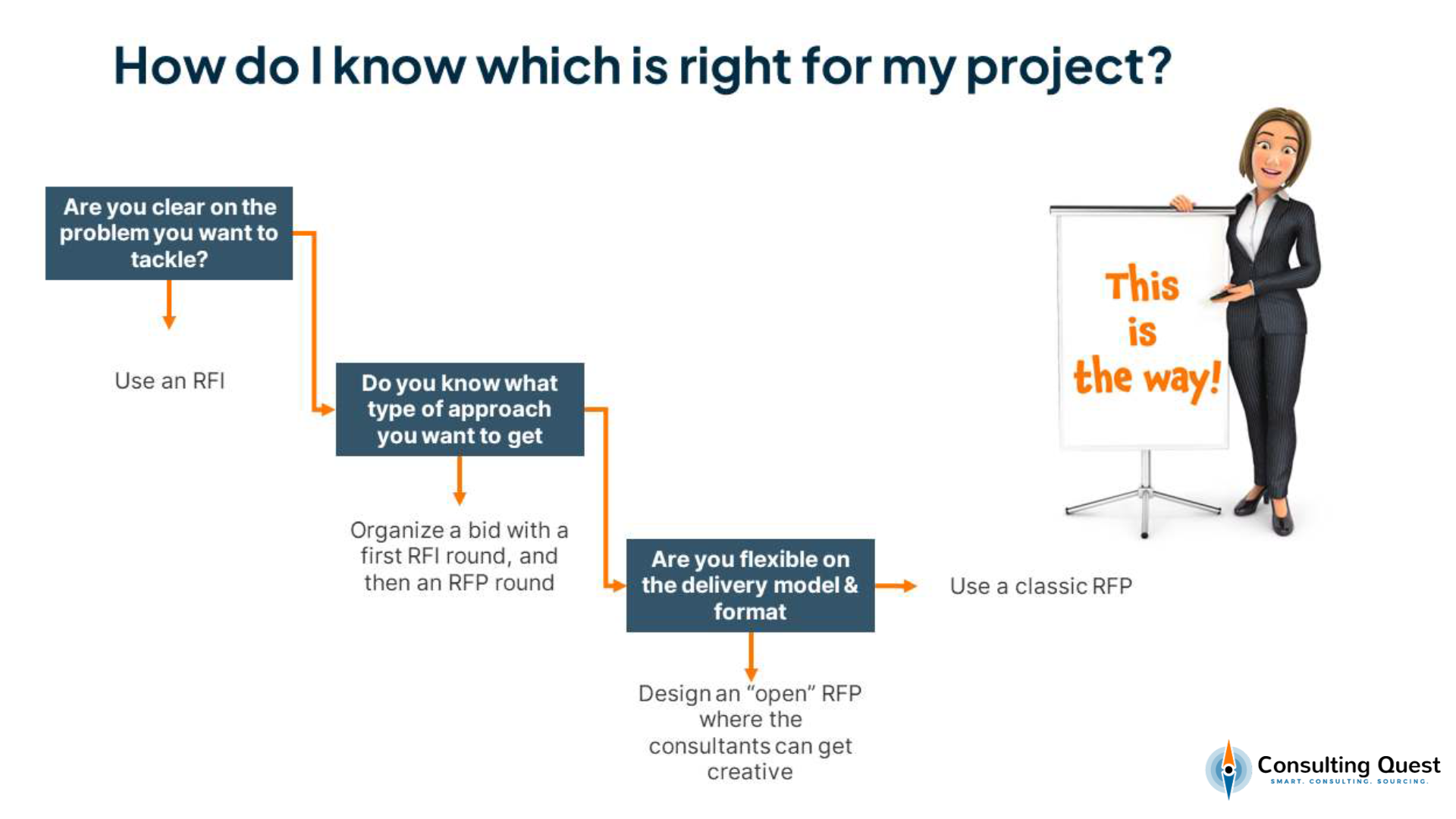
Because if you’re not clear on the scope of the project, there’s no way you can estimate the budget and it’s going to be very difficult to assess how strategic it is. And it also means that the procurement has to clarify the expectation for an RFP.
They need you to be clear on what elements they want to find in it, how detailed it should be and that specific part can depend on the size or the strategic value of a project.
It should also be clear what are the steps you are going to take when defining an RFP and also what are the roles and responsibilities of the different participants in creating the RFP.
So, you see that writing the RFP for consulting is not only a pure procurement activity. It’s of course, the first step to take control of your consulting spend, but also a very good way to increase collaborations and get the buy-in of the different stakeholders at the beginning of a project.

It will help you improve the relationship with consulting firms because you add transparency and clarity in the relationship, and also it helps the procurement to improve their credibility for the consulting category with internal stakeholders.
So, it’s a very important part of the procurement process & RFP for consulting services. And again, this is something that is an exercise that you must take for every project.
What Makes an Efficient RFP for Consulting?
An efficient RFP for consulting should be well-structured, clear, and concise to effectively communicate your requirements to potential consulting firms. Here are some key elements that make an RFP efficient:
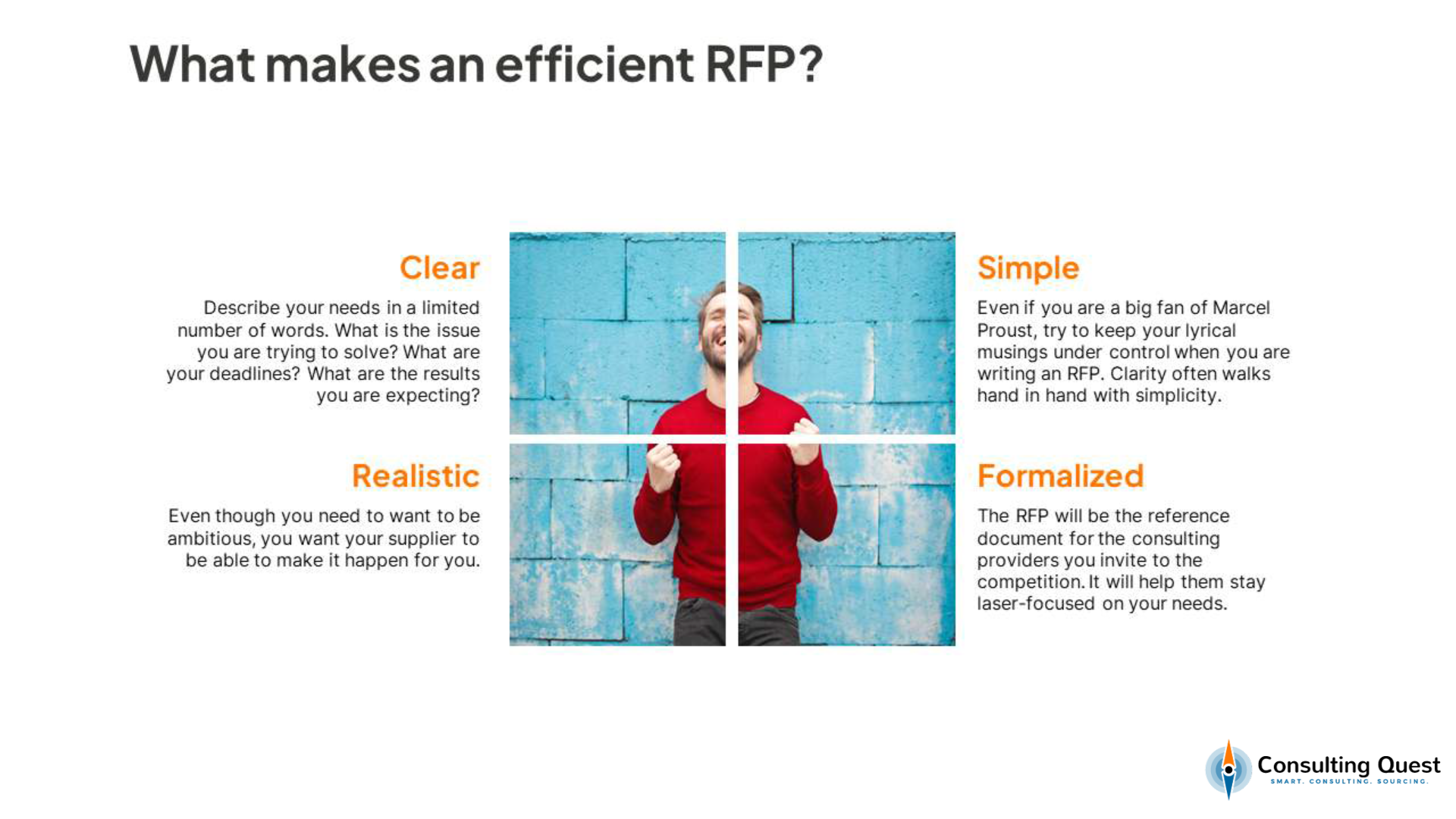
Keep in Mind What Makes a Great RFP for Consulting
The end of the game, when writing an RFP for consulting, is to maximize the chances of success of your purchase. You want to make sure that you will get solid proposals from your short-listed providers so that you can choose the best fit for you.
It means you have to convey your needs in a short document efficiently. There are a few basics when writing an RFP for consulting, independently of the type of goods or services you want to purchase.
Be clear.
It is maybe the most important element of an RFP for consulting. You need to describe your needs in a limited number of words. What is the issue you are trying to solve? What are your deadlines? What are the results you are expecting?
If you are not sure about your exact needs, you can organize a small workshop internally with the main stakeholders. You can also use the RFI process to get a sense of what can be done.
“Nothing is so simple that it cannot be misunderstood.”- Freeman Teague Jr
Keep it Simple.
Even if you are a big fan of Marcel Proust, try to keep your lyrical musings under control when you are writing an RFP. Clarity often walks hand in hand with simplicity.
You should also be mindful that many consultants are not native English speakers. Even a proficient speaker can struggle with a complicated structure or fancy vocabulary.
Besides, you will have the opportunity to go into more details during the briefing of the short-listed providers.
“Simplicity is about subtracting the obvious and adding the meaningful” – John Maeda
Set Realistic Goals.
Even if you want to have big goals and are very ambitious, you also want your supplier to be capable of achieving them for you. If you’re unsure about what can actually be accomplished, don’t hesitate to start a first round of discussion with potential providers by using a Request for Information (RFI).
“The goal you set must be challenging. At the same time, it should be realistic and attainable, not impossible to reach.” – Rick Hansen
View the Process as Seeking Solutions
Thinking outside the traditional RFP for consulting box starts with reminding yourself that you’re not making a purchase. You’re solving a company problem.
Provide all the information—the “why, what, who” details—that will enable your future supplier or partner to get what your company is all about, not just your product or service. Describe in detail your need for the project, and how you currently think of the scope.
Amid the rapid pace of innovation and technological advances, your RFP for consulting has a new role to play: an opportunity to procure something beyond the scope of what you had in mind—a solution that may go above and beyond merely filling your current need.
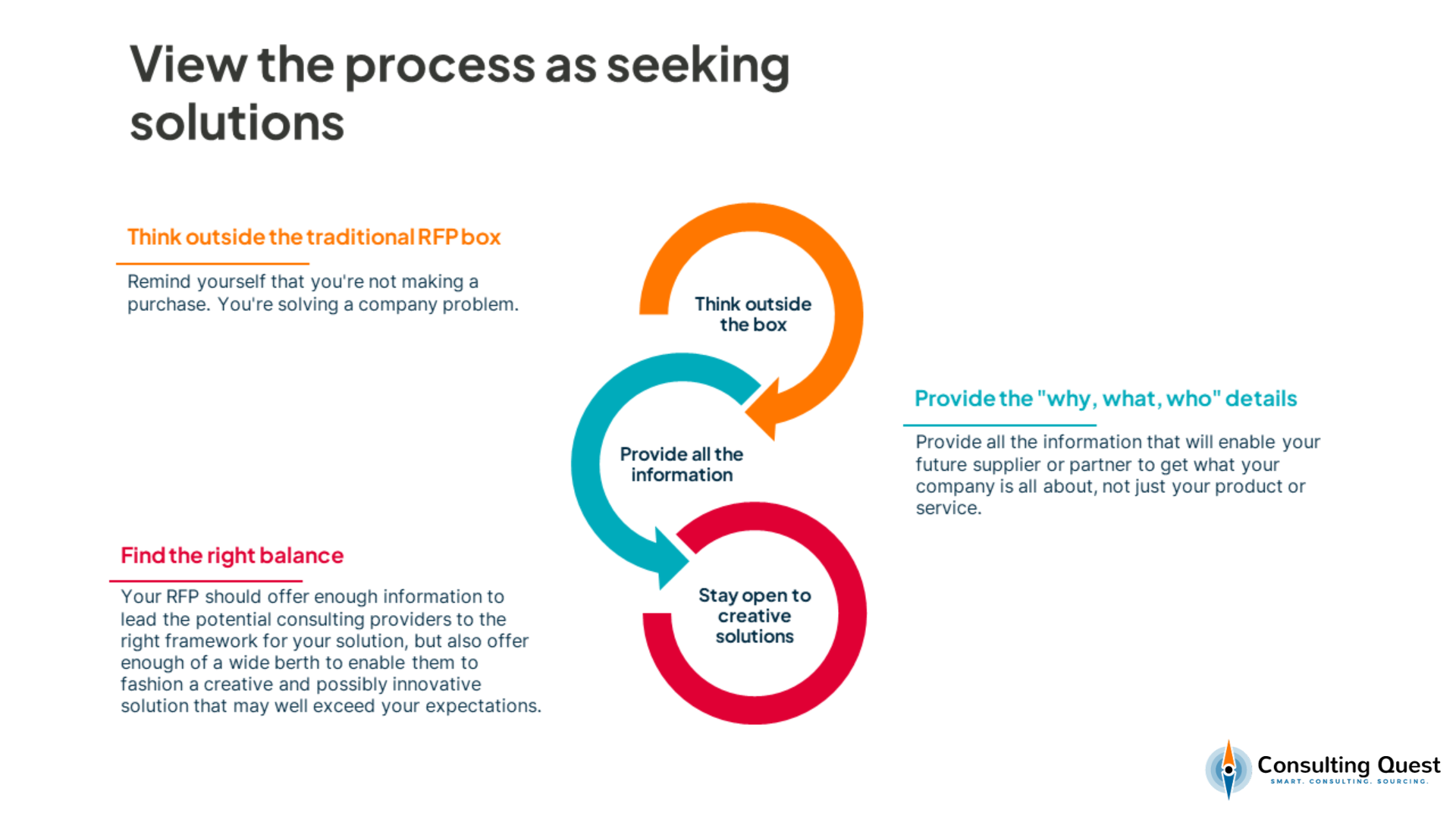
Let’s take a moment and imagine that Apple, for example, had put out an RFP for a new type of iPhone that was significantly smaller yet packed with features. We can imagine getting back a proposal just for an iPhone that was an inch square in size and which fit better in a pocket because the RFP restricted the scope of the product requested to a type of iPhone.
Now let’s allow ourselves to imagine that Apple instead had put out an RFP for a new device with no specs other than that it had to fit in with the Apple brand. In this more open-ended scenario, it becomes possible to propose a wristwatch that would include iPhone features and more—a product beyond what Apple executives may have had in mind.
So, there you go. Your RFP should offer enough information to lead the potential consulting providers to the right framework for your solution, but also offer enough of a wide berth to enable them to fashion a creative and possibly innovative solution that may well exceed your expectations.
Look for Understanding, Ability, and Fit
Once you have applied these sound principles to your RFP for consulting, you can look into the questions it should answer for a consulting project:
- Will the consultant clearly understand the issue we are trying to tackle?
- Is the consultant able to tackle the issue?
- Will you and the consultant work well together?
As you can see this sounds rather simple, right? So, let’s move to the action.

What are the Key Elements of an RFP for Consulting Services?
The Context
Why you are launching this consulting project and what are your main expectations?
The Requirements
What are the rationale for the project, the objectives, and the expected outcomes?
The Process
Who is their point of contact and how will the sourcing process unfold?
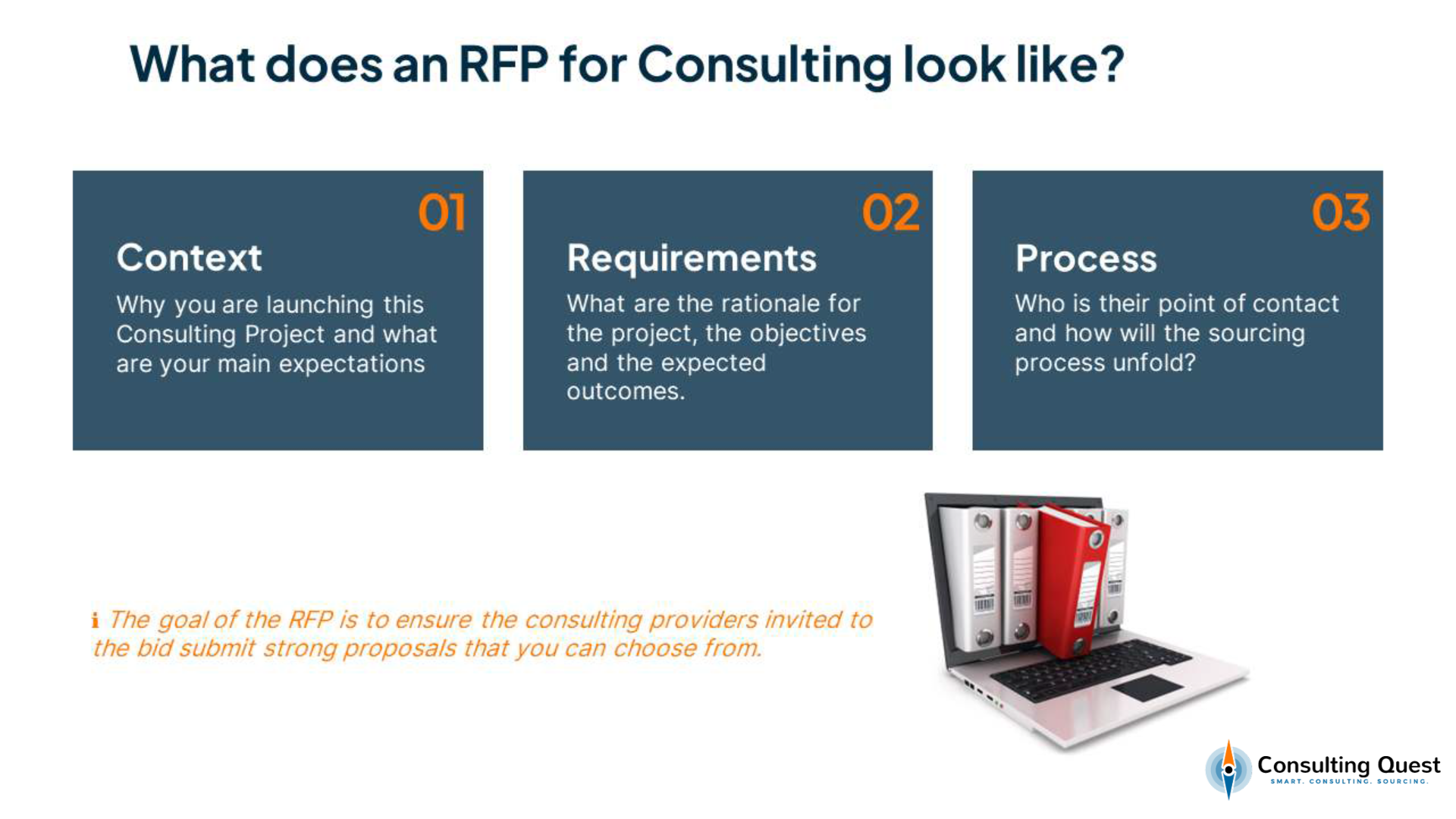
What are the Pre-requisites Before Writing an RFP for a Consulting Project?
Even before you start brainstorming on your ideal outcome, you need to make sure that the right people are in the room. Now depending on the magnitude of the project, you can adapt the size of your team. However, here are a few roles that need to be at the table:
The Project Sponsor
The Project Sponsor is the person (often a manager or an executive) that will be accountable for the project. She or he will make sure that the project delivers the expected outcomes, and will champion the project to “sell” it within the project team and the organization. She or he will also be the chair of the Steering Committee.
Evidently, the Project Sponsor has the right authority and decision-making level to lead the project effectively. She or he is also directly impacted by the project outcomes.
Usually, the project sponsor owns the budget. However, in some companies, consulting budgets are centralized under the CEO, Finance, or Strategy. In this case, you might want to invite the budget owner to the party as well.
The Project Manager
The Project Manager is the person that has the daily accountability of the project. She or he will steer with the consultants to make sure they work in the right conditions with the teams and deliver the expected results in time.
She or he is very often part of the Project Sponsor Team and is impacted directly by the project.
The Procurement Leader
Unless you are working on a very small project and already have a list of potential providers in hand, you want to have someone from procurement in the room. Sourcing the right candidates can take some time, and it is sometimes useful to start early in the process.
Besides, procurement managers are skilled at determining requirements and creating proposals, which is not typically the case for other people in the organization. They can make your job easier and provide assistance throughout the process.
Many companies, however, don’t have the critical mass to have someone dedicated to consulting procurement. In that case, you can include the person in charge of indirect procurement or the Head of Purchasing in your team.
The Main Stakeholders
We previously stated that the project sponsor and project manager are frequently on the same team. However, they may not be the only ones affected by the project.
Ask yourself if you should expect a strong impact on or a profound change in interfaces with another part of the organization. If that’s the case, it can be a good idea to involve your main stakeholders at the requirements stage.
Suppose your project is very large, like a company-wide transformation project. In that case, you might also want to involve finance and strategy to ensure that it is aligned with the overall strategy.
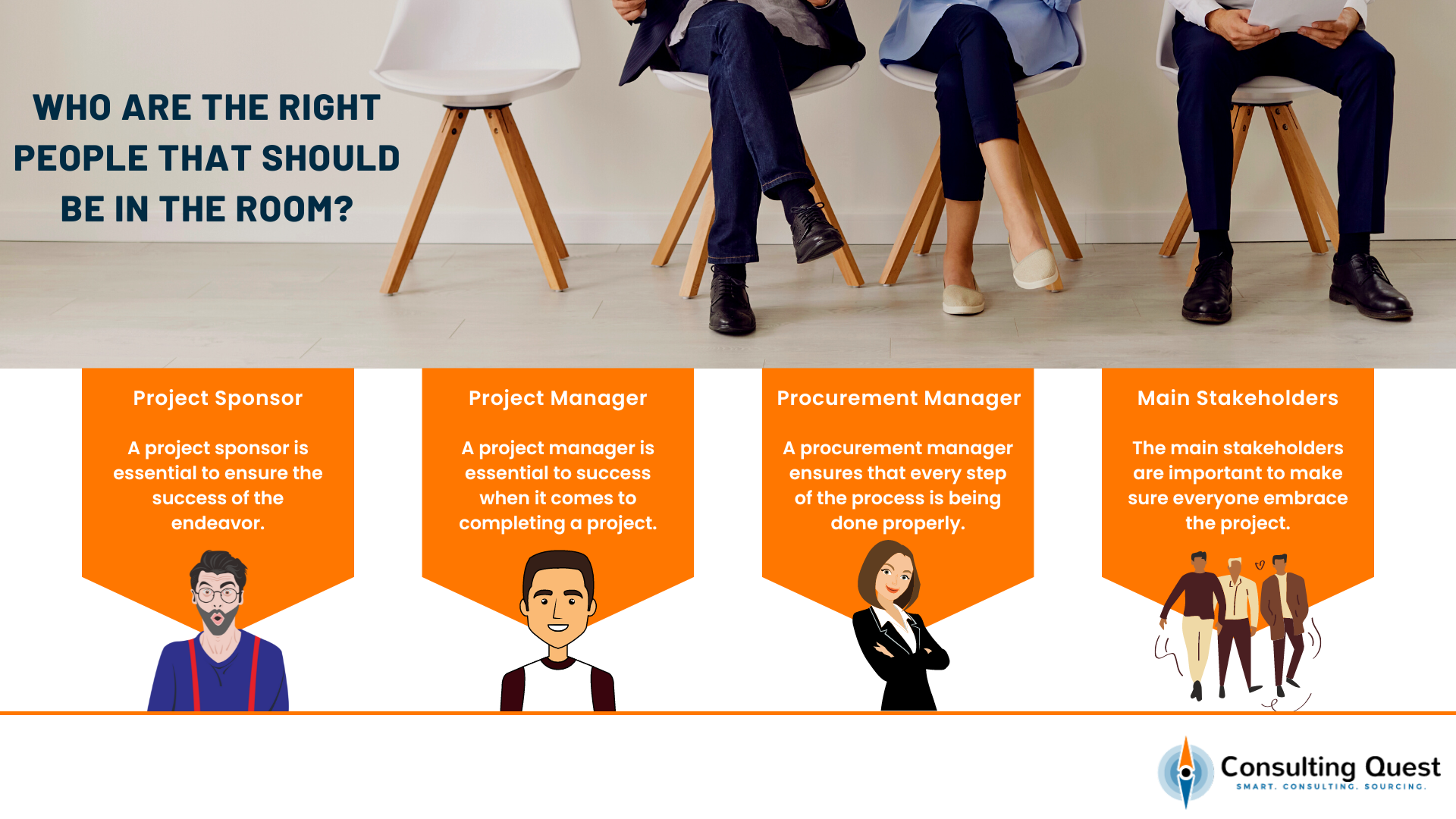
When you have the right team at work, you can start brainstorming.
How to Define the Expectations of Your Project?
There are many ways consultants can bring value to a project, but very few of them can guess what you expect if you don’t state it in plain English. The best way to start is to reformulate your problem statement at the start of this section.
Remind the consulting firms included in the RFP for consulting process about what are the objectives as well as the expected outcomes. If you have specific expectations regarding benefits, now is probably a good time to express them.
The high-level objective can be clearly defined in a few lines. However, many roads if not all of them are leading to Rome. You might need to add some precisions on the scope, the level of confidentiality, who should be involved on your end, and your timeline for the project.
There is a fine balance to find when you describe the expected deliverables. Some companies tend to describe at the same time the what and the how. However, as soon as you start describing how the consulting firm should produce the deliverables, you lose the creativity and experience an external provider can bring.
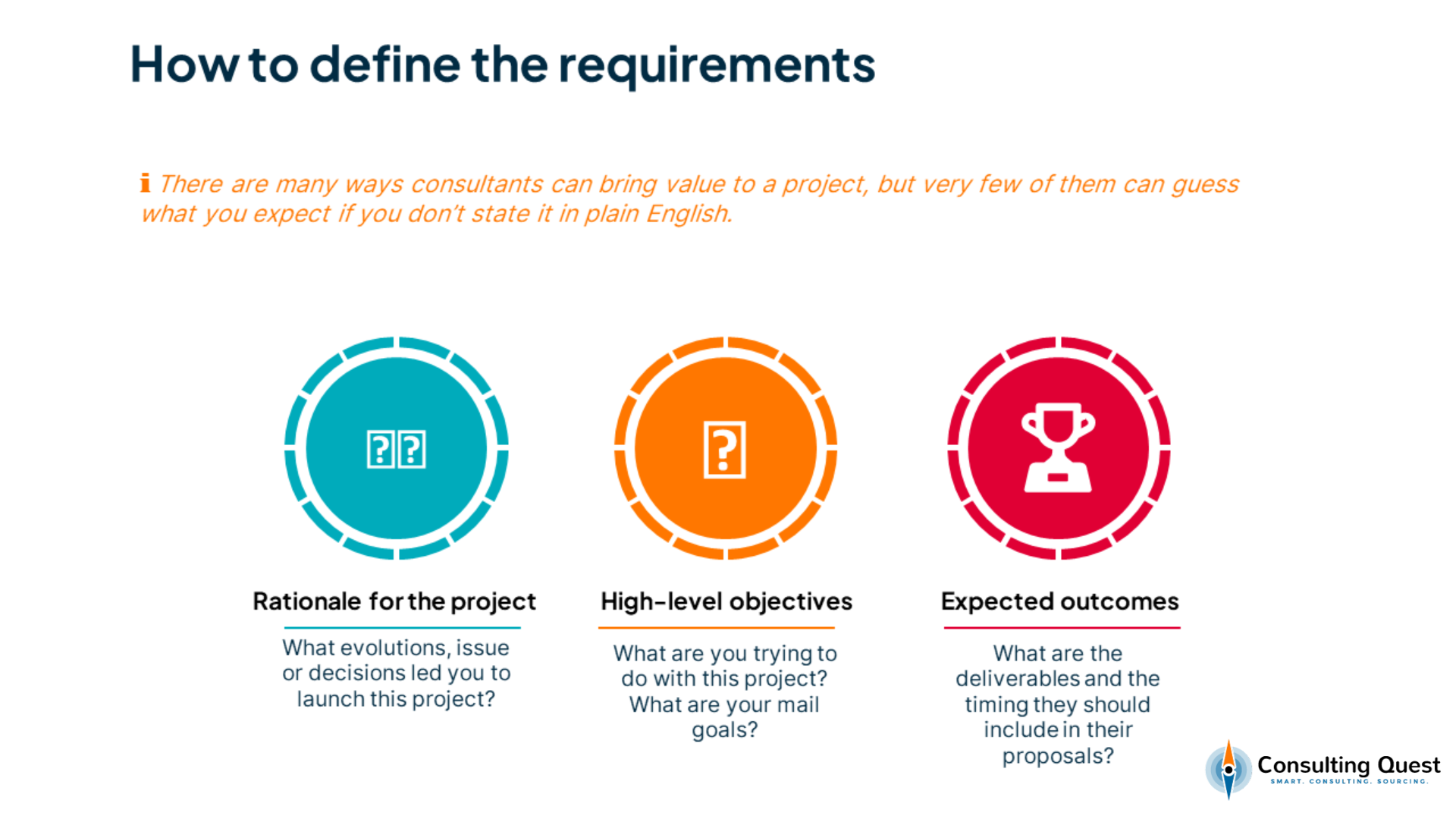
You automatically reduce the consulting firm to an externalized workforce. This can be okay if you have a clear understanding of the work that needs to be done, but it’s not considered the best way to approach it.
Our experience shows that even if you might be tempted to specify the methodology, it is important to leave room for the consultants to propose how they would approach the question.
It does not prevent adjusting later on and will most often provide a fresh perspective. The objective of the project is to identify the best investment opportunities for NewsCo in the value chain in the region.
Phase 1: Framing
- High-Level value chain landscape
- Definition of high-level prioritization methodology for NewsCo
- Identification of best opportunities for NewsCo leveraging outside-in benchmark of other facilities in the same field, and including economic attractiveness and key success factors (identification of where to play and associated conditions to win)
- Selection of priority opportunities to be further analyzed in phase 2
- Possible targets/players to partner with and/or M&A
Phase 2: Deep Dive on selected opportunities
Clustering of opportunities into options of potentially actionable scenarios, depending on resource level and expected returns (definition of how to get there and win)
- High-Level Business Plan for the retained options
- Strategic Marketing Analysis
- Top-Line and Margins Potential
- Resource Requirements (investments, raw materials, …)
- Manufacturing/Partnership Strategy
- Long-term Master Plan for NewsCo
Do not hesitate to add additional information that could be implicit for you but that companies less familiar with you cannot anticipate:
- Do you expect the consultant to do everything on his own or do you anticipate a joint team?
- Will the work be performed on-site?
- Is there a preferred location? Specific language requirements maybe?
- Do you have specific requests regarding knowledge transfer at the completion of the project?
- Are there additional “side questions” that should be addressed?
“We have a specific cultural integration issue on a plant located on the Chinese side of the border between Korea and China. Understanding of both cultures is key. The Mandarin language is a plus.”
At this stage let’s place ourselves in the shoes of the consulting firm. The context is clear, and the objectives and deliverables have taken shape. Now the key question is to be selected for the project.
Describing how you intend to proceed with the selection process is key to guaranteeing a fair process and ensuring that companies will decide to participate.
How to Describe the Context of Your Assignment?
What you want to convey in this section is why you are launching this consulting project and what are your main expectations. As we have mentioned earlier, do not hesitate to engage in a few conversations with consulting firms before issuing the RFP for consulting to sharpen your views on the project progressively.
It is not unusual to realize when you start explaining your needs that you are indeed embracing a scope too large or that the project could indeed be broken down into smaller pieces.
The context should provide a high-level overview of the problem. So, start with giving the basics. What is the state of your industry? What are the main challenges you are facing? What have you done so far? What would you like the consultant to help you with?
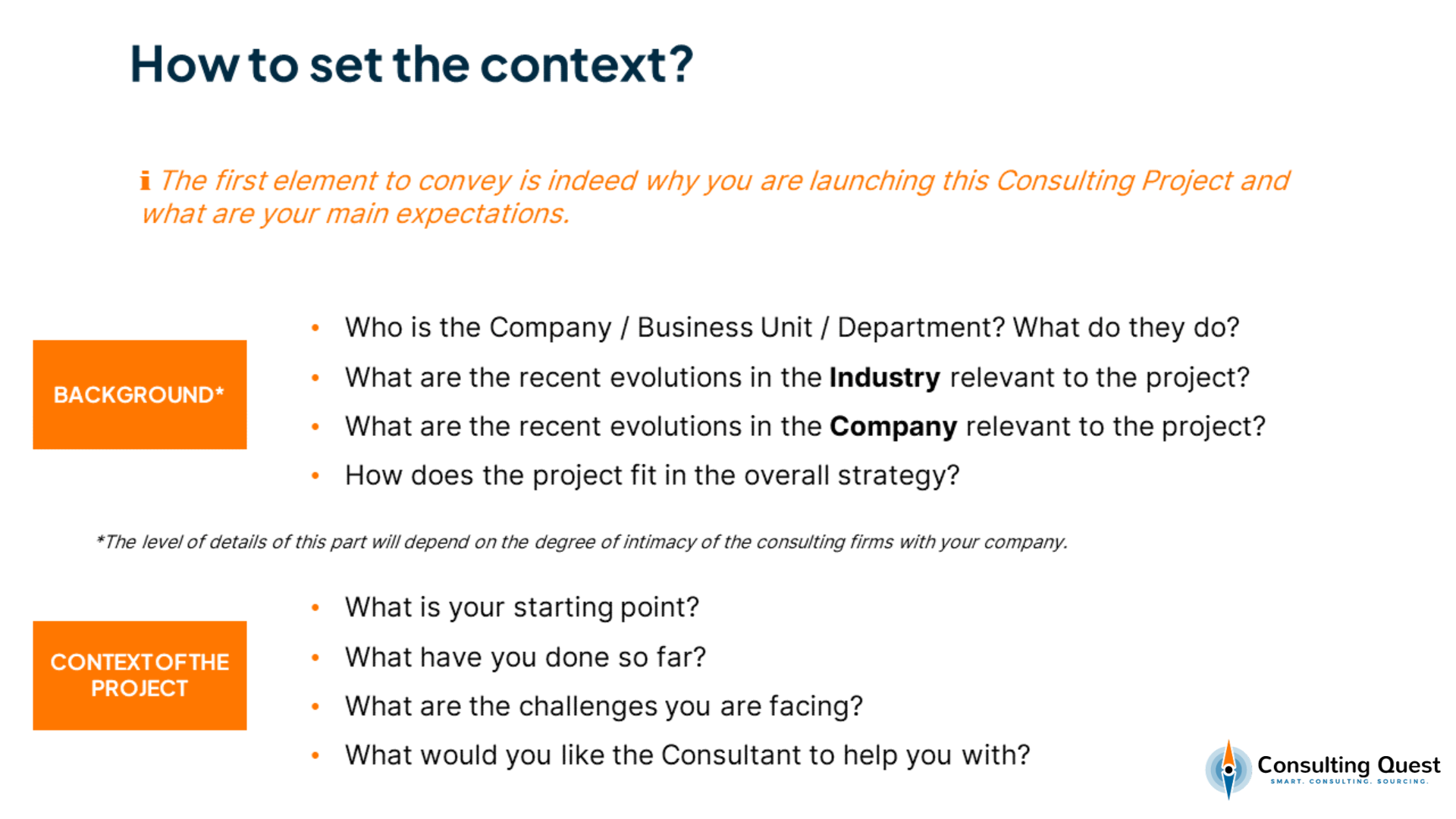
“Slow Economic Growth in Europe, in particular, compared to other markets, has limited the growth of the Insurance Industry. After a slight increase in 2017, growth went down again in 2018.
In 2016, new European regulations, namely Solvency 2, started to be implemented. As a result, the pressure on risk and compliance functions increased significantly. European politics could also impact the regulatory stance in major markets.
As a result, Risk is becoming more than ever a core function in the organization. Insurers need to adjust business processes and strategies to this new environment. In 2017, Insurance Co. created a Risk and Compliance team at the group level to supervise the implementation of Solvency 2 in the different business units.
Insurance Co. would like to now review the various options for organizing its risk activities at the corporate and business unit level and identify the most efficient set-up while taking into account the position of the regulators on this critical matter.”
At first sight, it sounds like a simple organizational design project. However, if you look closer, some key elements seem to be missing.
- The context doesn’t give any information about the results of the existing Risk and Compliance team. Why does the corporate team want to re-organize the risk function only two years after the creation of the team?
- There is no mention of the political dimension of the corporate relationship with business units, which is often a key element in an organization project.
- It might also be interesting to provide some benchmarks on existing models and anticipate the position of the regulator.
All these elements will help the consultants to understand exactly where you stand on the path to success and design a proposal customized to your needs.
You can also define the high-level questions you want to answer with the project:
The following structuring questions need to be addressed:
- What is the existing performance of the industrial setup? How do we compare with the competitors?
- What are the high- and low-performers by function?
- What are the different opportunities to harmonize the organizational structure?
- What are the best options to improve the efficiency of the organization based on an internal benchmark?
- For each option, what would be the impact/risks to consider? The associated costs and potential benefits?
A first high-level assessment shows a potential of 7% of savings that will contribute to the overall synergy objective of the merger.
Once the context is set, you can move to the description of your requirements for the project. Keep in mind to integrate into your RFP the questions consulting firms would ask to be able to provide a solution tailored to your needs.
You can use a sparring partner or another member of your team to review and make sure the context is clear and accurate.
Why is it Important to Introduce Your Company in an RFP for Consulting Services?
Depending on your degree of familiarity with consulting firms, you may want to provide more background about your company, your business unit or your department and how it fits in the overall scheme of things.
It can be a good way to level the grounds when introducing new players in the competition. Understanding the background of a company is key for the consultants to identify potential comparable projects and clients in their past experience.
You can start with a high-level presentation of your company including your industry, your footprint, some part of your company story as well as some of your financials. The goal of this section is to give an overview of your business to the consultants.
“Insurance Co. is a world leader in personal lines property and casualty insurer in Europe, serving more than 25 million households. Founded in 1920, Insurance Co. has been dedicated to protecting our customers from life’s uncertainties and preparing them for the future for almost 100 years.
Headquartered in Germany, Insurance Co. is present in approximately 15 countries across Europe and generated round about $150B in total assets in the year 2019.”
Your next step is to describe your business and/or your department. You need to include all information that might be relevant for the project such as your footprint, your organization, your reporting lines, etc.
“Global Direct Procurement is the department in charge of direct procurement operations at the group level. It sources all raw materials used in more than one business unit of the group, as well as describes and manages the procurement policies for all direct procurement activities within or without the Global Direct Procurement group. The group is composed of 30 employees, mostly based in Germany.”
Finally, if relevant, you can share some of your strategic ambitions for the future to help the consultants understand how the project fits in with your overall strategy.
What are the Other Elements to Include in Your RFP for Consulting?
Describe How the Selection Process Will Unfold
First, let’s begin by explaining the key steps in the consulting process. It is important for consulting candidates to understand how much time they have to prepare and submit their proposal. It will also give them an idea of when the project could start.
Usually, at this point, you should have signed a Non-Disclosure Agreement (NDA) with the potential candidates. Even if this step is not mandatory, we highly recommend you protect your confidentiality.
The main steps in the RFP for consulting project are (see image below):

As you can see in the above timeline and even if this is not about writing an RFP for consulting per se, we strongly recommend involving several stakeholders from your firm as a selection committee and organize face to face discussions with the finalist (or leverage new technologies like Skype or Google Hangouts).
Then, let’s have a look at the proposal content. To enable proper comparisons, do not hesitate to specify in your RFP for consulting a few expectations on what the proposal from the consultant should include.
“The proposal content should include a description of the objectives pursued, the approach and deliverables, the planning for the project highlighting the key milestones as well as the project management structure proposed (including the contribution required from the client).
To demonstrate its competence, the consulting firm should provide references on similar projects (industry/capability), the CVs of the actual consultants that are expected to work on the project and examples of Thought Leadership they have produced in the field.
Fees and workload should be detailed enough to enable a clear understanding of the cost structure associated with the project.”
Finally, you should describe how the Q&A between sending RFP for consulting and receiving the proposal will be organized. When should the question be sent? How will the answers be shared with the consulting providers? And so on.
Share the Criteria for the Decision
Selection criteria and expectations for the proposal have to be explicit. In principle, you know already how you will perform the selection. If not, well, that is the right moment to think about it.
Selection criteria are usually a blend of (see image below):
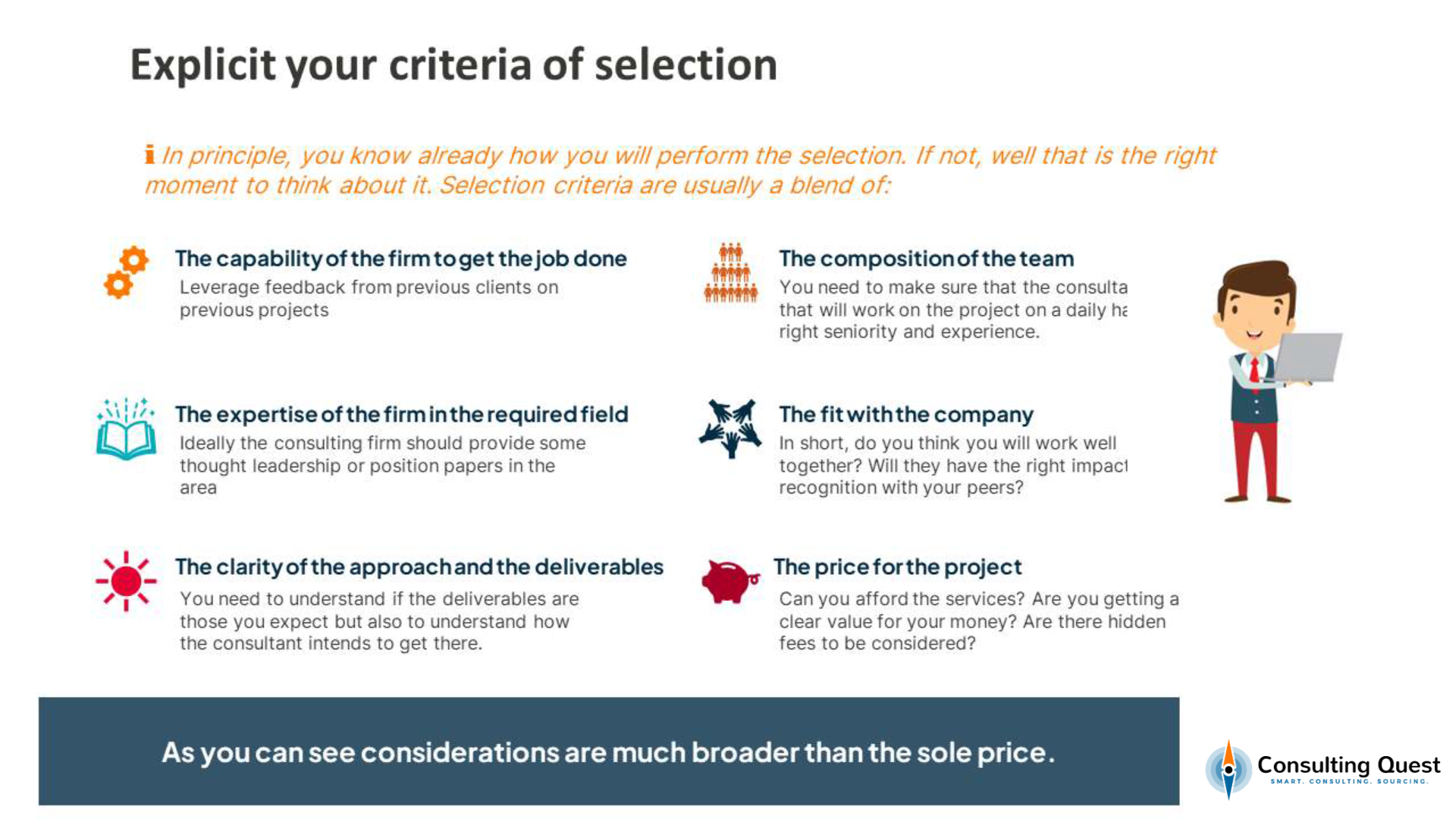
As you can see, considerations are much broader than the sole price. Even though there is no magic formula using clear criteria, communicating them to the consulting firms early in the process is key to getting a high-quality proposal and taking informed and fair decisions.
Unless your project is not urgent, you have a timeline in mind or at least some internal deadlines or meetings. Knowing your schedule for the project is key for the consulting candidates. It will directly impact the team composition and the cost of a project.
For instance, let’s imagine you have an extremely important meeting with your CEO in 8 weeks, where you need to give the main orientations of your “Fancy New Business Strategy” for instance.
You will need to have your results for a Market Analysis and Strategic opportunities at least 2 weeks before your meeting. It means a 6-week project. If the project is based on the assumption of 12 weeks for 3 consultants (one manager and two consultants), the consulting firm will need to expedite the project to respect your deadline.
They will probably build a team of one manager, one senior consultant, and four consultants to compress the project in 6 weeks. It might come with a premium to make sure the resources are secured full-time for your project.
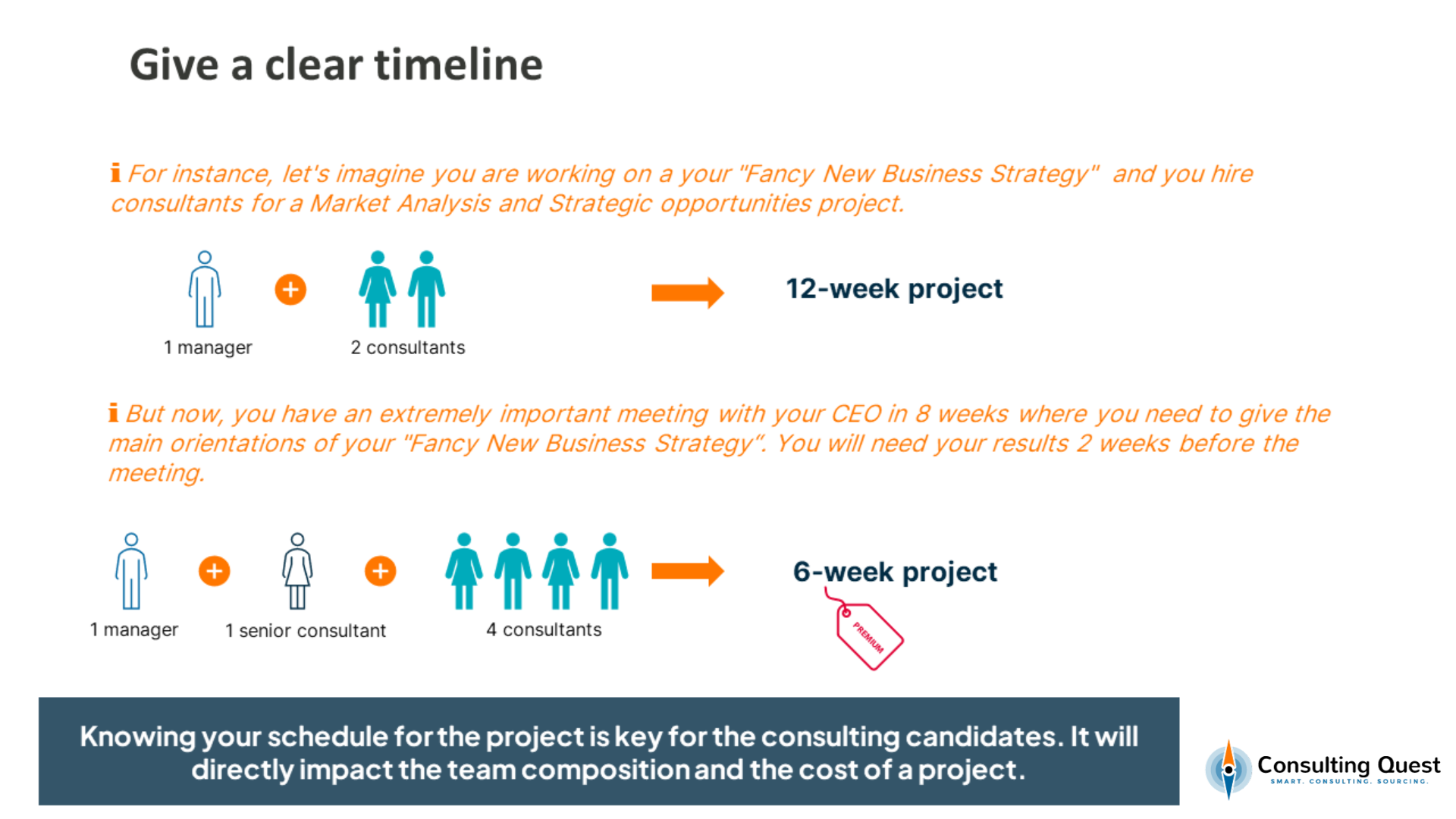
Users and buyers rarely include their budget in the RFP for consulting. However, if you are on a very tight budget, it might make sense to include that information in the RFP to make sure that you don’t lose time for proposals you cannot afford.
Besides, the consultants will be able to come up with trade-offs or design-to-cost proposals.
Mention Your Other Requirements in the RFP for Consulting
You might have other requirements that you want to include in your RFP for consulting services. For instance, you might be interested in having references and contact information to check the references.
You can also maybe have some eligibility criteria linked to your internal procurement policies. Probably your consulting providers have to be registered as a provider.
Don’t Forget to Give a Single Point of Contact
You also need to define the main point of contact during the process. Will it be someone from procurement, one of the executives, or even a third party? All the interactions with consulting firms during the RFP for consulting process should go through that person.
Letting the consulting firms connect directly with the executives of their choice would give an advantage to the incumbents and distort the competition.
Final Thoughts
Crafting an effective RFP for consulting services is an intimidating feat, especially if you’ve never done it properly before. But with the right guidance and resources, it can be a much simpler undertaking than you’d expect.
This guide helps you understand what goes into such a process, break down the steps for creating an appealing request to vendors, provide advice on choosing a qualified candidate for the job, and even outline methods for successful negotiation.
Armed with these helpful tips, you’re sure to find the perfect consultant who will meet their needs perfectly – no matter how complex or ambitious. By taking the time to build and issue your RFP thoughtfully and correctly, you could be surprised by just how much of your project’s success boils down to getting started off on the right foot.
P.S: This comprehensive guide is now available in the form of a convenient flipbook. You can also simply click the download button and download it as a PDF for later viewing.







